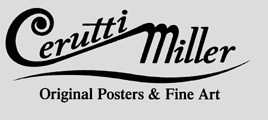 |
42 West 17th Street, 2nd Floor New York, NY 10011 (212) 645-0808 phone (212) 924-7978 fax gallery@ceruttimiller.com www.ceruttimiller.com |
| Works by:
|
Jules Chéret Just how potent that force was can be estimated from Charles Hiatt's assessment, written in 1895: "Many have produced charming wall pictures: nobody, save Chéret, has made an emphatic mark on the aspect of a metropolis. Paris, without its Chéret's, would be Paris without one of its most pronounced characteristics; Paris, moreover, with its gaiety of aspect materially diminished. The great masses of variegated colour formed by Chéret's posters greet one joyously as one passes every hoarding, smile at one from the walls of every café, arrest one before the windows of every kiosque. The merits of the Saxoléine lamp, the gaieties of the Moulin Rouge, the charms of Loïe Fuller, the value of a particular brand of cough lozenges are insisted upon with a good humoured vehemence of which Jules Chéret alone appears to know the secret. Others, in isolated cases, have possibly achieved more compelling decorations, but none can pretend to a success so uniform and so unequivocal." "Chéret is utterly original, " chimes in Charles Matlack Price in 1913, "generally subversive, and sometimes almost exasperating in an audacity which throws all precedent to the winds, and launches lightly clad female figures, floating -- ephemeral as so many soap bubbles, sparkling, iridescent, and explosive. They seem evoked from nothingness, born of daring and fantastic gaiety, and seem joyously to beckon the beholder on with them in a madcap, elusive chase after pleasure." Jules Chéret (1836-1932), the man who was to exercise such a profound influence on his trade, was born in Paris just about at the time when the first posters produced by the lithographic process were being pasted on the billboards and vacant walls around town. But they were still crude affairs, composed mostly of large type and few border curlicues; lithography, although available as a technique since 1798, was a slow, clumsy, extremely expensive method of printing, economically impractical for posters. And, in fact, most at this time were printed by metal or wood-block engravings, with some hand coloring added for effect at times. It was Chéret, the lithographic innovator - he became a printer's apprentice at the age of 13 - as well as the artistic and advertising genius, who formulated the technical means to produce posters of every shading of the rainbow with just three or four stones and thus, for the first time, made the color pictorial poster an economically feasible marketing instrument. Moreover, as the little magazine Poster Lore stated in 1896, "It was not until Jules Chéret, the magician of the brush, began to design his posters with their startling color effects and odd originality, that poster designing attracted attention as a special branch of art." He gave posters life and proved they were art; and to top it off, he produced, in a career spanning more than half a century, more of them than anyone else. Lucy Briodo, in her definitive catalogue, lists 1,069 of them; but many of his early ones will probably never be traced. That's a remarkable achievement for any artist, and the fact that in all this prodigious output he managed to maintain a consistent level of inspiration and spontaneity is nothing less than phenomenal. Naturally, in that many designs, he had to hard back to similar themes, yet no Chéret poster is ever dull, stale or lacking in original creative spark. Chéret's first posters were done for the theater. In 1858 he sold a design for a poster advertising the new light opera, "Orphée aux Enfers, "to its composer Jacques Offenbach, allegedly for 100 francs. Encouraged by this, he continued to learn his trade in London, where color lithography was at an advanced stage; he produced some more posters there, and on his return to Paris in 1866 he was ready to open his own printing shop. Almost immediately, he had more commissions from Offenbach, and other theatrical work followed. Magazine and book publishers came next, and by 1881 he was doing so well he merged his operation with a larger printer, Chaix, who thereafter produced all his work. In the beginning, Chéret based his designs on the illustrative techniques of the day but soon he began to understand that the needs of a poster are different, and evolved his own standards. The mainspring of everything is almost always action - and this he depicted with such irrepressible vitality that it is impossible not to notice it, and once having done so, impossible to ignore it: in most cases, it involved one of his patented soaring beauties. Whatever background and supporting figures are needed are drawn and colored simply to give the design some depth, but never to distract from the central action: the figures are indistinct, the colors have darker tones, perspective is not strictly adhered to, and there are no elaborate details or embellishments. Chéret was in every way a pioneer, an innovator, a mentor - the prophet of the poster. Biography excerpted from: |
|
Click here to return to Chéret's posters
|
|